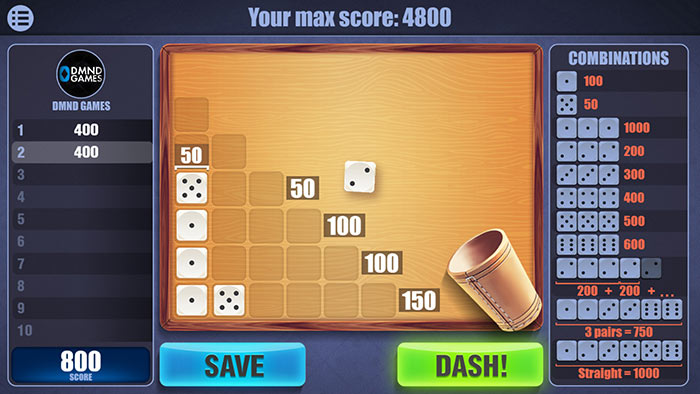
Farkle Strategy
Farkle is a game that students play in their dorm rooms, as well as one of the most popular gambling activities in casinos. It's a lighthearted and enjoyable way to pass the time. Farkle's other names include Zilch, 6 Dice, Ten Thousand, Squelch, and Hot Dice. Despite the fact that the game is quite famous and dates back to the 1980s, no one knows for sure where it came from.
Farkle is a popular party game in the United States, and it only requires three items to play:
- There are six basic dice, each with six sides.
- A score sheet as well as a pen or pencil is required.
- One or more dice cups, though you can roll the dice with your hand if you like.
Farkle's basic rules are as follows:
Farkle requires at least two players to play, but the game is best enjoyed with at least three and a maximum of eight players. There are several variations of the game rules, but we'll stick to the conventional ones to make it easier for newbies to understand.
First, get your scoring sheet ready and decide who will begin the game. Now the player must roll the six dice and see what numbers he or she receives. They will be awarded a particular number of points based on the combination of numbers they received.
Assume a player is dealt three fours and no other pairs. They remember the 400 score, put the three fours aside, and reroll the other dice. If they don't get any more score able numbers on their roll, they lose the 400 points. If they roll three more fours, for example, they will gain another 400 points, bringing the total to 800.
Transferring the play to the next player:
The dice are passed clockwise to the next person at the table when the first player's turn is completed. This is where things start to get interesting, because the next player can change their approach to outsmart the one before them. Consider the risk against return carefully depending on how many points the last player had before you.
Strategies for Farkle:
Every seasoned Farkle player understands the thrill of rolling a high-scoring combination right away. The thrill of a perfect 6 of a Kind, the thrill of a 1-6 Straight, the thrill of two trips or a trio of pairs. This is the kind of roll that Farkle gamers fantasies about. There's no way to roll them in a strategic fashion. They are unavoidable. But if they don't, it's up to you to figure out the best way to get the greatest possible score. Farkle is similar to a blackjack game.
The luck of the draw – or, in this case, the luck of the roll – has a significant impact on the outcome of each game. The players that grasp the odds and probabilities, and use those mathematical numbers to their advantage to make the best selections throughout, will win more frequently in the long run.
The strategies outlined here will help you win Farkle against average players and put you on an equal footing with other strategists. You don't have to be an expert mathematician to win at Farkle. Strategies for a variety of scenarios are simple to devise. You should have no issue adapting to the top winning tips below if you know the Farkle regulations.
Opener (500):
It can be difficult to roll the required 500-point opening score. Slow-rolling and scoring on all 6 dice (with triplets, 1s, and/or 5s) is often easier than rolling them all again to obtain the required 500 points. Make every effort to go passed that phase so you can continue playing the game.
Fives for Fun:
What exactly do you get if you roll a pair of 5s? It may be 100 points or a chance to roll for a large sum of money. Don't be satisfied with a score of 100. Keep one of the fives and roll again. When you roll five dice, there's a good chance you'll get a 1, a 5, or both – if not something far better – matching or increasing the original point value.
Don't Get Angry Over the Little Things:
Expanding on the preceding point if a roll is worth less than 200 points roll it as long as you have three or more dice left to throw, Unless you're playing for a triple Farkle, it's usually worth sacrificing little points for a chance at a high point play.
Any four-figure score can be banked:
It's not easy to roll a 1,000-point score or higher. Stop if you get a four-figure score. Pass the dice and bank the points.
Avoid a Triple Farkle:
Never take even the tiniest chance of getting a triple Farkle. If you've previously Farkle twice, take whatever score your initial throw produces on the next turn to avoid losing 1,000 points for a third Farkle.
Small 3 of a Kind:
When you get a high-scoring 3 of a Kind in the 4s, 5s, or 6s, bank it right away. Lower triples in the 1s, 2s, or 3s, on the other hand, aren't usually worth scoring on their own. If these come up on the second or third roll, bank the points and go on to the next player. Set them aside and roll the other three dice if they appear on the initial roll with no other points connected. You'll have a better than 50% probability of rolling a higher number.
Dice of Fire:
When rolling for Hot Dice, be extremely cautious (scores on all six dice is worth a second chance to roll all six dice). Only do this if you're behind or having trouble reaching the 500-point opener, and you don't have two Farkles in a row.
Keeping the Advantage:
When you're in the lead, never take a chance. There isn't much else to say about this.
More Farkles = Less Dice:
Another no-brainer: the fewer dice you have to roll, the more likely you are to Farkle. Stop and bank those points if you scored on the first two or three rolls (unless you're far behind or need more points to open).
Roll For Broke: The 10k Threshold:
You've got nothing to lose after another player reaches the 10,000-point mark, indicating the end of the game. Take any risks necessary to achieve the greatest possible score.
Think Accordingly:
When an opponent's score exceeds 8000 points, you should consider playing a little more aggressively. Especially if your total is less than $5,000. It's time to take the gloves off when the difference between your score and the leader exceeds the difference between the leader and winning the game. When you have two dice to toss, don't stop at 400 points. Continue to toss.
Optimality Equations and Method of Solution:
Farkle's game tree has chance nodes where 1–6 dice are rolled, as well as maximizing option nodes of two types: banking decision states about whether to roll or keep and scoring decision states about how to set aside die combinations for points.
Variations in scoring
Because Farkle is a folk game, different playing communities use different rules. Even though the above-mentioned standard rules are extensively employed, they are not ubiquitous. For example, three 1's are scored as 300 instead of 1000 in the commercially advertised game of Pocket Farkle. Furthermore, some players score one or more additional dice combinations in addition to the normal ones.
Conclusion:
Farkle is a game that requires both luck and strategy. It's a fun way to place bets or just spends time with friends, family, and other people. You may outwit other players and become a true Farkle champion among your tight circle if you evaluate your actions and risks properly.
FAQs:
Is it possible for me to play Farkle online?
Yes, you certainly can. There are a variety of websites where users can play a few rounds of Farkle and create their own variations, often for free. However, not all of these websites have the security features that one would expect to secure their personal information and privacy. Fortunately, enterprising entrepreneurs may use Farkle and a variety of other games to create their own websites, which can be played for free or for real money.
How can you bring Farkle to a close?
If a player scores on all six dice, he or she must roll them all at least once again. A player loses 1000 points if he or she rolls three Farkles in a succession. A single roll of four or more 2s negates the player's total score for that turn and instantly terminates their turn.
What's the best way to roll a Farkle?
With play passing to the left, whoever has the highest roll goes first. Place the six Dice in the Shaker Cup and roll them when it's your turn. Any dice that roll outside of the playing area are re-rolled. Set aside any dice that are worth points after each roll and roll the remaining dice.
Is Farkle a good game to play?
Farkle is a dice game that is both entertaining and challenging. It is widely regarded as the best dice game in the world, second only to Yatzy. Farkle necessitates a combination of strategy and luck. The goal is to be the highest-scoring player at the end of the last turn.

